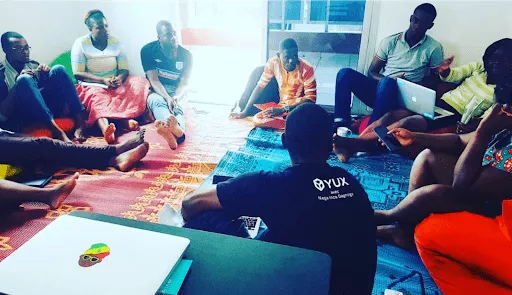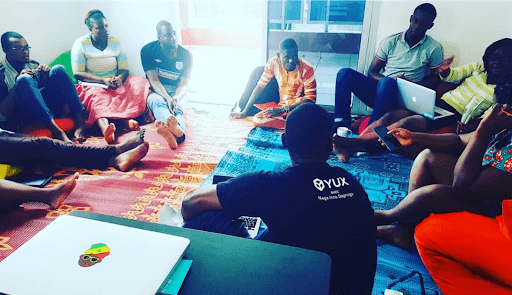
Yeah, indeed we luckily survived 2020! It was tough and much less fun than our previous years. But we learned a lot, and could really see this year the strengths and weaknesses of our business. So we thought sharing some excerpts of our journey so far could be useful for other design companies or agencies starting from the continent.
We actually did not start a business in the first place…

Our cofounder Daniel sharing with local designers at our first YUX Meetup in Abidjan in 2017
In may 2016, Camille, Daniel and I, started to do some free design workshops and training in Senegal. We had all lived in Senegal for between 3 to 12 years and were frustrated by the lack of digital products really thought with and for the Senegalese users. After a few sessions and a dozen early fans (literally, we were 5 or 6 people at our first workshops!), we got approached in early 2017 by companies which wanted our support for UX-UI Design projects. Soon we started providing consultancy to top local tech companies like Orange and InTouch. We knew there was a need at the time, but frankly did not think companies were actually ready to pay for it. That is why we never did any business plan or even revenue objectives for our first 3 years…. Each year we are like: huumm, we survived again, that’s cool!
3 years down the road, we are greatful for where we stand. In a nutshell: we are now a research and design group with 35 people spread across 5 African countries, with an independent Saas venture (LOOKA), a training center (YUX Academy) and a subsidiary in video games (KayFo). We worked across 20 African countries and even in Asia for big names like Facebook, Square, GSMA, the MIT, MTN, Amnesty, UNESCO and amazing local startups like Yoco, Affinity, Worldcover, Farmbetter & Paydunya.
To this day, no external investors have contributed to our growth, only our hard work and personal savings We wanted, unconsciously I believe , to prove that with the right mindset and people, anyone in Africa can build a company from scratch and compete with global firms which are luring on the continent.
An anecdote: at the toughest part of 2020, at the time when we had to let go a few people to save the company, one of our first employees came to us and told us that she (had to be a she of course!) was ok if we cut her salary by 50% to save some money! We were shocked. We did not realize how much some of our Yuxies cared for the company. We refused her offer but her gesture inspired us.
We never took the time to reflect on this 3 years journey so far but our friend Corona forced us to do so and reconsider a lot of things in 2020. We had a tough year, with no revenue almost from february to september, but we evolved, survived and finally even grew our revenue by 45% from 2019.
That’s why we wanted to share with local designers and entrepreneurs some of the stuff we learned the hard way growing YUX. These are just straight bullet points, no fluff, but feel free to leave a comment or get in touch if you’re facing a similar situation and want to know more. Our goal writing this article: having more amazing design (or niche-focused) firms coming from the continent.
Disclaimer: we have an hybrid model between a service (agency) and product-based (saas) firm, so these good practives may not apply to you if you’re 100% one or the other.
STUFF WE BELIEVE WE DID WELL
1. Build a transparent relationship between co founders
We started for the first 6 months as 5 individual consultants working under the same umbrella - this enabled us to test each other and our collaboration before committing to something bigger. As individuals, we were making a lot of money (more than today!) but it was not a company.
Then we decided to create a company and to keep all the money in our bank account : i.e not getting paid, for 1 year! Two of the guys who were with us left. I was working full time on YUX and relied on my little savings and Camille and Daniel were still working part time at their previous jobs for a few months before joining full time the venture. A tough time for all of us.
From the start we recorded all our expenses and revenues in a shared Google sheet and debated every Franc CFA we did not understand the purpose of.
Cofounders do at least a weekly session to discuss the business progress, community activities, objectives and responsibilities.
2. Choose a niche and be the best at it (at least on our continent!)
For us it was obvious, the mix of user research (inspired by ethnography and anthropology practices) and UX-UI Design was the best way to help organisations develop product that are very well adapted to their customers and reflect their cultural diversity
We stuck to this niche and grew it by evangelizing and training our clients and talents. To this day, we don’t sell logo, branding, website or software development - we only do user research and experience design.
3. Do not count days and hours on clients
I know, that’s a bad agency management practice! But well, at this stage of early maturity of our market, the most important is for our clients to understand the value of design and grow with us! Key number: in 2020, 89% of our revenue came from existing clients, so it pays.
4. Focus on junior people, train them and share your values
Consider yourself as a school as much as a company and structure your training programs for internal students within your agency as much as external one. Our Academy, which trained 70 researchers and designers since 2019, is the best pipeline of talents for us. However, we noticed that the best way for students to learn is to work on real clients projects. So now we offer intense 2 weeks online training followed, for the best only, by a 3 months internship in the Agency.
Slowly pick talents (in-house ideally) to create your middle management and give them lots of freedom. We do not have a formal middle management layer yet as we want to stay as horizontal as possible, but naturally you’ll see some leaders / teachers emerge in your group. Invest even more in them and give them a lot of responsibilities.
We involve all these “middle managers” (around 10 people) in our strategy day every 6 months.
Fun fact: all the women of the company happen to be part of this strategic committee!
Of course, stay open to a few mid-level talents (around 26-30 years old) that can come from anywhere - having a few of them really speed up the learning process and make sure you preserve your deliverable quality.
Do 1 on 1 on a regular basis. These individual monthly (and weekly for the most junior) meetings are crucial for your colleagues' development. They have to prepare it in advance as it is their meeting and always use this opportunity to train them on something specific and very importantly talk about their private environment and life. It may seem strange for a western world reader, but in our African context you have to understand the life of your employee (married or not, how many kids at home, transport, etc) to better support them.
5. If you’re based in Francophone Africa, move your A** and get to the other side of the wall
58% of our revenue in 2020 came from projects in English speaking Africa (Nigeria & Ghana mostly) - compared to only 7% last year! Our niche market is a little more mature over there so now our company does everything in English and we hired full time researchers in Rwanda, Nigeria and Ghana and established strong links with partners in Kenya andTanzania. The transition was (is!) not easy but that’s one of the hard moves that helped us survive this year.
We built a strong partnership with an amazing designer from Ghana, Dela Kumahor, and together got several gigs including a 2 years contract for amazing research and design work across 7 countries! However, everyday we have to show Dela and our clients that we can be at their level - which frankly sometimes is not easy since we have a super dedicated but still pretty junior team. Co-founders had to support largely this year on that. I myself spent at least 70% of my time in 2020 doing research interviews, design workshops, functional specs and backlogs.
At the beginning of 2020 we launched a new website… in English only! 70% of our posts on social media are also in English. Choose your fights!
LOOKA helped us explore other markets very rapidly. Its Saas model enabled us to find clients and build a network of local part-time researchers in 20 countries before investing in hiring full time people.
6. Invest in your products and have a dedicated team for it
Before 2020, we were working on 3 to 4 in-house products with very little link between them. During the Covid first months and to this day, we could not do qualitative research face to face anymore, so our revenues got hit hard and made us focus on only one our quantitative research Saas LOOKA and stop totally the others - LOOKA went on to generate from 1% of our revenues to 22% at the end of the year.
Internalize your tech team, if you think it makes sense for you in the long term - ask yourself: “will I need developers full time 5 years from now?” If the answer is yes, then take your time but build a team.
Hire a top-notch CTO (ours, Moussa looks young but he is way above 35 years-old without revealing any secret…) and surround him by junior but specialized developers in front-end, back-end and mobile.
Invest in a product manager. Our lab’s product manager, Pierre, was our 2nd employee and he almost always worked on our internal products. That’s an important financial commitment but it pays in terms of structuring your dev processes and the user experience of your products. It also shows to all in the team how important products are for your company.
Find an entrepreneurial talent to lead the business development of your products. But don’t make the mistake to select someone for his “biz dev / cute face / speaking skills”, it doesn’t work! Select someone who knows the field and the problem you’re trying to solve with your software. Selling Saas products is not about sales skills, it’s about passion for the issue. Make sure you give those guys a lot of trust and space. For instance this year, LOOKA, our Saas for market research, is an autonomous business unit with its own budget, set of values, office space (in the same building still), t-shirt and other stuff ! That’s not easy to “let go” your baby but as the group leader you have to focus on the big picture and make sure you build the infra-structure (finance, admin, hr, office, IT, etc) that your team needs to go fast.
And of course
don’t do any pitch competition - even for your products, invest all your resources in building them and then finding clients
Pay your F***** tax - and believe me that’s a lot when you hire people in several countries. But you don’t want to have any surprises… or at least reduce the risk.
Hire a (good) external firm for your accounting -- but do your own cash flow analysis on a regular basis. You need to understand your business.
make it clear to your employees that they are not freelancers (no side gigs on your company’s core business !)
say no to client work that is not great for your team even though it can bring lots of cash
Thanks for reading this! In the second part of this article, we’ll share the most interesting part: what we did not do well! Stay tuned.
